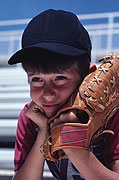
WEDNESDAY, March 10 (HealthDay News) — In the coming weeks, millions of American children will dust off their bats and gloves and head out to the baseball field.
But the season may end before it’s over for many if they don’t take steps to prevent the arm injuries that seem to be striking ever younger players, experts say.
New research indicates arm pain among young athletes is on the rise, with one study showing a five-fold increase in serious shoulder and elbow injuries among youth baseball and softball players since 2000.
A study of 152 players aged 8 to 12 by Japanese researchers found that 25 percent complained of elbow pain. Of those, 68 percent had limited range of motion or tenderness of the elbow, while nearly 85 percent had osteochondral lesions, or a tear or fracture of the cartilage around the elbow.
More than half of those with injuries were pitchers, 27 percent were catchers and the rest played other positions, according to the study to be presented Wednesday at the American Academy of Orthopaedic Surgeons annual meeting, in New Orleans.
“It’s a growing problem,” said Dr. Charles Metzger, an orthopedic surgeon specializing in the upper extremities in Houston who was to present his own research at the meeting. “It’s very common for younger and younger players to come in with elbow and shoulder pain and miss playing games as a result.”
Reasons for the rise in arm injuries include children specializing in a single sport, or even position, at younger and younger ages, leaving them more prone to overuse injuries, said Dr. Michael Schafer, an academy spokesman who spent 23 years as a team orthopedic surgeon for the Chicago Cubs.
Young athletes also play more months out of the year than they used to, said Metzger. In his survey of 1,261 male U.S. players aged 7 to 15, the average length of play was 6.3 months of the year — “and a lot of them play a lot longer than that,” said Metzger.
A third reason is that pitchers, who bear the brunt of the injuries, now throw curve balls and sliders at younger ages. Both pitches are associated with arm pain, Metzger said. In the survey, about 75 percent of 14-year-old pitchers said they threw curve balls, while about 6 percent of 15-year-olds said they threw sliders.
So what can young athletes, their parents and coaches do to prevent season-ending injuries?
“Simple rest, cross-training and stretching their throwing arm after they play can honestly prevent a lot of these injuries,” Schafer said.
If a player is bothered by pain, by all means rest the arm, Schafer said. When players come back, start out easy. Start throwing at 30 feet, then add 15 feet gradually over the course of several weeks until you’re back at 90 feet.
Young athletes should also cross-train by playing a variety of sports. Even if they are determined to become a major leaguer, the strength and skills learned from basketball, soccer or another sport may transfer back to baseball and can help prevent overuse injuries.
A third method of avoiding arm pain is by doing specific stretches to improve range of motion in the shoulder, Metzger said.
Overhead pitching causes the posterior-inferior glenohumeral ligament to toughen and tighten up, limiting range of motion and leaving players vulnerable to cartilage tears, Metzger said.
In his study, pitchers were twice as likely as fielders to have a significant loss in the range of motion, measured by comparing the rotation of the throwing vs. the non-throwing arm. Players with a decreased range of motion were significantly more likely to report pain, according to the study.
About 95 percent of those who did the stretches had improved range of motion over time, while about 65 percent of those who didn’t do the stretches got worse over time, according to the study.
“If we can make it required that kids stretch after pitching a game, we can significantly lower the number of kids who have to quit baseball because their [of] arms pain or injury,” Metzger said. “My take-home message here is to do your stretches. They help.”
More information
For more on preventing pitching injuries, visit the American Academy of Orthopaedic Surgeons.

